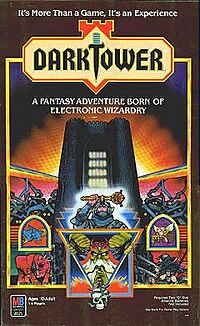
Scotland Yard is a board game in which a team of players controlling different detectives cooperate to track down a player controlling a criminal as they move around a board representing the streets of London. It was first published in 1983. It is named after Scotland Yard which is the headquarters of London's Metropolitan Police Service in real-life. Scotland Yard is an asymmetric board game, during which the detective players cooperatively solve a variant of the pursuit–evasion problem. The game is published by Ravensburger in most of Europe and Canada and by Milton Bradley in the United States. It received the Spiel des Jahres award in 1983-the same year that it was published.

Twister is a game of physical skill produced by Milton Bradley Company and Winning Moves Games USA. It is played on a large plastic mat that is spread on the floor or ground. The mat has four rows of six large colored circles on it with a different color in each row: red, yellow, green and blue. A spinner tells players where they have to place their hand or foot. The game promotes itself as "the game that ties you up in knots".

Axis & Allies is a series of World War II strategy board games. The first version was initially published in 1981 and a second edition known colloquially as Axis & Allies: Classic was published in 1984. Played on a board depicting a Spring 1942 political map of Earth divided by territories, players take the role of one or more of the five major belligerents of World War II: the Axis powers of Germany and Japan; and the Allied powers of the Soviet Union, the United Kingdom, and the United States. Turns rotate among these belligerents, who control armies of playing pieces with which they attempt to capture enemy territories, with results determined by dice rolls. The object of the game is to win the war by capturing enough critical territories to gain the advantage over the enemy.

Jenga is a game of physical skill created by British board game designer and author Leslie Scott and marketed by Hasbro. The name comes from the Swahili word "kujenga" which means 'to build or construct'. Players take turns removing one block at a time from a tower constructed of 54 blocks. Each block removed is then placed on top of the tower, creating a progressively more unstable structure. The game ends when the tower falls over.

Battleship is a strategy type guessing game for two players. It is played on ruled grids on which each player's fleet of warships are marked. The locations of the fleets are concealed from the other player. Players alternate turns calling "shots" at the other player's ships, and the objective of the game is to destroy the opposing player's fleet.
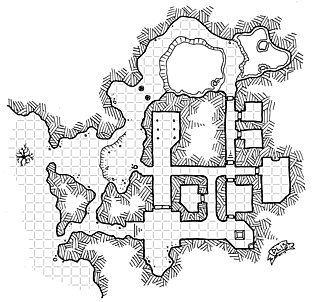
A dungeon crawl is a type of scenario in fantasy role-playing games (RPGs) in which heroes navigate a labyrinth environment, battling various monsters, avoiding traps, solving puzzles, and looting any treasure they may find. Video games and board games which predominantly feature dungeon crawl elements are considered to be a genre.

Shogun is a board wargame set in feudal Japan, first released in 1986 by game maker Milton Bradley.
Advanced HeroQuest is a board game published by Games Workshop in 1989, a sequel to HeroQuest.

Merlin is a handheld electronic game first made by Parker Brothers in 1978.

Cooperative board games are board games in which players work together to achieve a common goal rather than competing against each other. Either the players win the game by reaching a pre-determined objective, or all players lose the game, often by not reaching the objective before a certain event ends the game.

Easy Money or The Game of Easy Money was a board game introduced by Milton Bradley Company in 1935. Like Monopoly, the game is based on The Landlord's Game in the movement of pieces around the board, the use of cards, properties that can be purchased, and houses that can be established on them.

Milton Bradley was an American business magnate, game pioneer and publisher, credited by many with launching the board game industry, with his eponymous enterprise, which was purchased by Hasbro in 1984, and folded in 1998.

Thunder Road is a post-apocalyptic themed racing board game invented by Jim Keifer and published by Milton Bradley. Using an assortment of four different vehicles each ranging from a modified dune buggy to a gyrocopter, players must race down an infinite roadway against one another. The goal of the game for players is to either be the last player team alive or simply out race the other teams. Although the game was originally published by Milton Bradley in 1986, Hasbro currently owns the rights to the game, since it acquired Milton Bradley in 1984.

The Game of Life, also known simply as Life, is a board game originally created in 1860 by Milton Bradley as The Checkered Game for Life, the first ever board game for his own company, the Milton Bradley Company. The Game of Life was US's first popular parlour game. The game simulates a person's travels through their life, from early adulthood to retirement, with college if necessary, jobs, marriage, and possible children along the way. Up to six players, depending on the version, can participate in a single game. Variations of the game accommodate up to ten players.

Mansions of Madness is a tabletop strategy game designed by Corey Konieczka and published by Fantasy Flight Games in 2011. Players explore a locale filled with Lovecraftian horrors and solve a mystery.
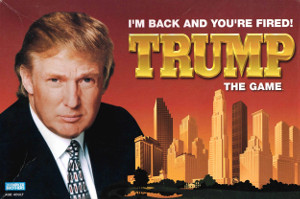
Trump: The Game is a board game named after Donald Trump. Milton Bradley Company initially released the game in 1989, but it sold poorly, with only 800,000 copies sold out of an expected two million. Parker Brothers re-released Trump: The Game in 2004 following the success of Trump's reality television series, The Apprentice, from earlier that year. Trump: The Game received poor reviews from critics and the public audience.
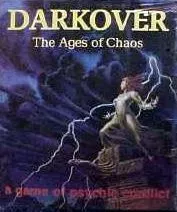
Darkover, subtitled "The Ages of Chaos", is a board game published by Eon Products in 1979 that is based on the Darkover novels by Marion Zimmer Bradley.
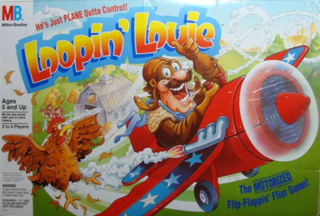
Loopin' Louie, is an interactive electronic board game designed by Carol Wiseley and published by Milton Bradley in 1992. It was given the Kinderspiel des Jahres award in 1994. Although the game is designed for a maximum of 4 players, unofficial modifications were made by modders to increase the maximum number of players to eight. A Star Wars variation called "Loopin' Chewie" was produced by Hasbro in 2015.
Return to Dark Tower is a board game for one to four players, designed and published by Restoration Games. The game is a sequel to the 1981 board game Dark Tower, by Milton Bradley Company. Return to Dark Tower has players cooperate or compete as they rule over kingdoms surrounding the titular Tower, with their chosen "heroes" gathering resources, defeating monsters and enhancing their strength. As the game progresses, the Tower dispenses corruption across the land, which players must cleanse, while also looking to identify the foe inhabiting the Tower, so that they may defeat it, to win the game. Return to Dark Tower features a circular mat that is sectioned into quarters, to represent the kingdoms, with a Bluetooth-powered Tower at the center, which is connected to an app that runs the game.
Bob Pepper was an American illustrator whose work included record and paperback covers, greeting cards, magazine illustrations and game artwork, between the 1960s and 1980s.
